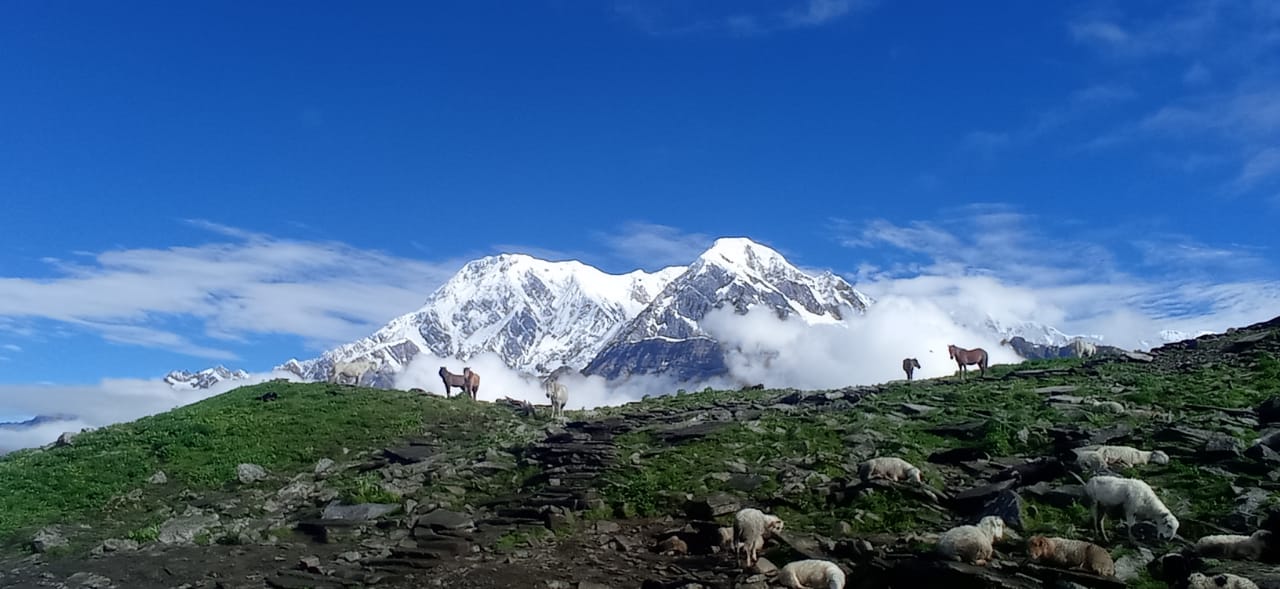Surrounding Mardi Himal
The Annapurna and Mardi Himal regions are part of the greater Annapurna Conservation Area (ACA) in central Nepal — a spectacular, diverse, and culturally rich Himalayan zone. Here’s a breakdown of the geography, treks, peaks, villages, and ecosystems surrounding Mardi Himal and the Annapurna Massif to help you visualize the area:
Major Peaks often visible during the Mardi Himal Trek
| Mountain Name | Height (m) | Notes |
| Annapurna I | 8,091 | 10th highest in the world
|
| Annapurna South
|
7,219
|
Dominates views from ABC & Mardi Himal
|
| Machapuchare (Fishtail)
|
6,993
|
Sacred, unclimbed, iconic silhouette
|
| Hiunchuli
|
6441
|
Between ABC and Mardi Himal |
| Mardi Himal
|
5,587
|
Prominent ridge off Machapuchare |
Geographic Layout surrounding Mardi Himal
Center: Annapurna Massif
A horseshoe of high peaks surrounding the Annapurna Sanctuary (home of ABC).
Mardi Himal lies to the east of this massif, on a ridge descending from Machapuchare.
East of Mardi Himal:
Pokhara Valley (gateway city)
Seti River gorge
Terraced hills, Gurung villages (e.g., Dhampus, Siding)
South of Mardi Himal:
Australian Camp, Pothana, Forest Camp
Rhododendron forests, subtropical hills
Leads into Phedi/Kande and highway to Pokhara
West of Mardi Himal:
Landruk, Jhinu Danda, Chhomrong — common stopovers en route to Annapurna Base Camp
Hot springs near Jhinu
North of Mardi Himal:
High alpine terrain, leading to the foot of Machapuchare and Mardi Himal Base Camp (4,500m)
Trek Itinerary
Day 01: Drive to Kande From Pokhara then trek to Deurali via Australian Camp 4/5 hours walk, 2005m. Stay overnight at the tea house.
Day 02: Trek from Deurali to Low Camp 6/7 hours walk, 2985m. Stay overnight at the tea house.
Day 03: Low Camp to High Camp 4/5 hours walk, 3550m. Stay overnight at the tea house.
Day 04: Hike to Mardi Upper View point (Mardi Himal Base Camp 4500m.) And back to High Camp 6/7 hours walk, Stay overnight at the tea house.
Day 05: Trek to siding 4/5 hours walk, and then drive to Pokhara for about 3 hours. And then goodbye to your guide and porter in Pokhara after you get Pokhara.
Alternatives Treks Routes Near by Mardi Himal
- Ghorepani–Poon Hill Trek (4-days) – epic sunrise views
- Annapurna Base Camp short Trek (ABC) (7- days) – classic route into the heart of the Himalayas
- Annapurna Base Camp private Trek ( 10- Days ) Via Ghorepani Poon Hill.
- Khopra Ridge Trek (10-days) – remote and panoramic
Key Villages and Settlements (Main Route Highlights)
- Pokhara (Start/End Point: – Beautiful lakeside town; gateway to Annapurna treks.
- Kande or Phedi: – Typical starting point for the trek (~1-hour drive from Pokhara).
- Australian Camp / Dhampus: – First views of the Himalayas; lush hills and terraces.
- Forest Camp (2,500m):- Deep rhododendron forests and peaceful trails.
- Low Camp (3,000m):- Start of alpine views; Machapuchare becomes more prominent.
- High Camp (3,580m):- Panoramic views of Mardi Himal, Annapurna range.
- Mardi Himal Base Camp (4,500m):- Final viewpoint; often reached on a sunrise hike from High Camp.
Landscapes
- Lush subtropical forests
- Alpine meadows and yak pastures
- Steep ridgelines with sweeping views
- Seasonal rhododendron blooms (March–April)
Cultural and Local Experience (Local Villages)
- Siding, Lwang, Landruk (if you exit via a longer route)
- Traditional Gurung and Magar communities
- Teahouses and homestays with local food and hospitality
Cultural Insights
- Buddhist and Hindu influences
- Prayer flags and small shrines along the route
Ecosystems & Conservation
- Annapurna Conservation Area (ACA) – Nepal’s largest protected area
- Encompasses tropical forests to alpine meadows
- Rich in biodiversity: red pandas, Himalayan monals, langurs
- Cultural diversity: Gurung, Magar, Thakali, and Tibetan Buddhist communities





